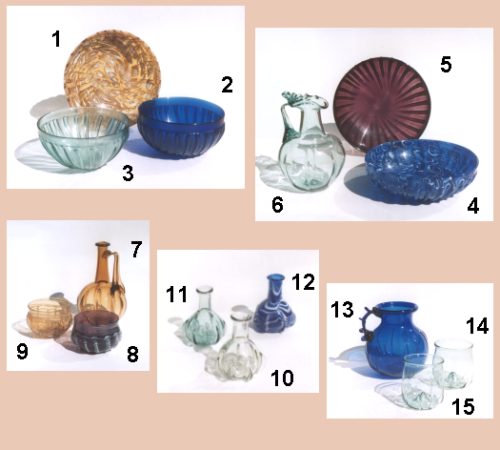

This exhibition ran from 25th May to 29th June, 2003. It featured the work of many of the past students of the International Glass Centre, Brierley Hill, and ran concurrently with the 'First Gather' exhibition, which featured the work of current students.

These vessels are linked by their decoration and by the method by which this decoration is made. They are all based on vessels dating from the 1st century AD.
The five bowls (1, 2, 3, 4, 5) are made by slumping a circular disc over a form. It is done 'live', i.e. not in a kiln, but using a glory hole, which enables the bowl to be worked on during this stage. The ribs have been formed by pinching each one with a pair of pincers whilst the glass is fluid and whilst the disc is still flat. The top of the exterior wall, the rim and the interior wall have been finished by grinding and polishing. Concentric circles have been cut into the interior wall of the monochrome bowls (2, 3, 5).
The results we have obtained using this rib-pinching technique have lead us to conclude that most original Roman ribbed bowls were made by this method.
All of the other vessels have been free-blown (with no use of a mould). The ribs have been pinched before the body has been inflated, and this is a style of decoration that is mainly seen on vessels that date from this early phase of glassblowing. In addition, the trefoil-lipped bottle (6) has pinched trails on the lip, and the handles of vessels 6, 7 and 13 are all decorated using pincers (in the case of number 7 the vertical pinched decoration has been elongated as the handle was formed).
We are also hoping to have a poster display at the Congress which will show details of our method of making these vessels.
We have a far more detailed article on this subject in the new British Museum Catalogue of Ancient Glass in the Department of Greek and Roman Studies.
More information about ribbed bowls will soon appear on our web site and in a future edition of our Newsletter.